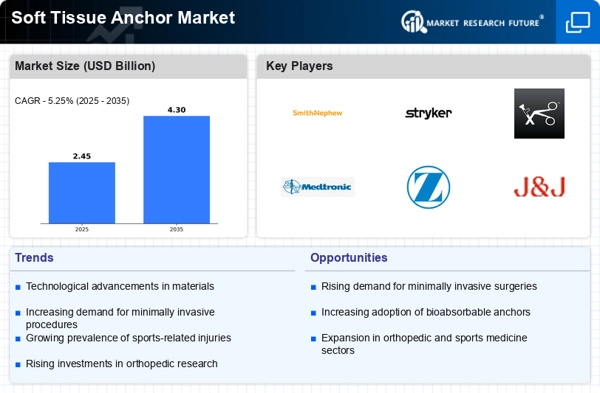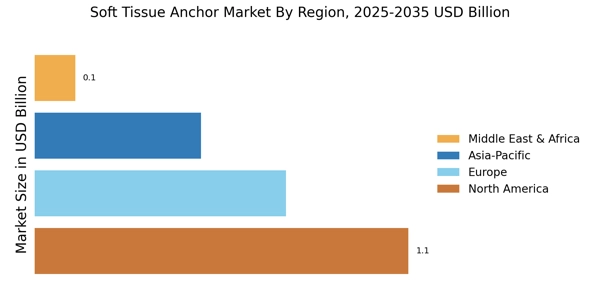Growing Prevalence of Sports Injuries
The rising incidence of sports-related injuries is a critical driver for the Soft Tissue Anchor Market. As participation in sports and physical activities increases, so does the demand for effective treatment solutions for injuries such as ligament tears and tendon ruptures. The market is projected to expand as healthcare providers seek advanced surgical options to address these injuries. Data indicates that sports injuries account for a substantial percentage of orthopedic surgeries, with soft tissue anchors being a preferred choice for stabilization. This trend suggests that the Soft Tissue Anchor Market will continue to grow, as athletes and active individuals increasingly require surgical interventions to return to their sports. The focus on rehabilitation and recovery further emphasizes the importance of soft tissue anchors in modern orthopedic practices.
Aging Population and Associated Health Issues
The aging population presents a substantial driver for the Soft Tissue Anchor Market, as older adults are more susceptible to musculoskeletal disorders and injuries. Conditions such as rotator cuff tears and knee injuries are prevalent among this demographic, necessitating surgical interventions that often utilize soft tissue anchors. As the global population continues to age, the demand for orthopedic surgeries is expected to rise, thereby propelling the growth of the Soft Tissue Anchor Market. Data indicates that the number of orthopedic procedures performed on older adults is increasing, highlighting the need for effective solutions to address their unique health challenges. This demographic shift underscores the importance of soft tissue anchors in providing effective treatment options for age-related injuries.
Increased Investment in Healthcare Infrastructure
The Soft Tissue Anchor Market is benefiting from increased investment in healthcare infrastructure, particularly in developing regions. Governments and private entities are allocating resources to enhance surgical facilities and improve access to advanced medical technologies. This investment is likely to facilitate the adoption of soft tissue anchors in various surgical procedures, as healthcare providers seek to offer state-of-the-art treatment options. Market data suggests that regions with improved healthcare infrastructure are witnessing a rise in orthopedic surgeries, which correlates with the demand for soft tissue anchors. As healthcare systems evolve and expand, the Soft Tissue Anchor Market is poised for growth, driven by the need for innovative solutions in surgical practices.
Technological Innovations in Soft Tissue Anchor Market
The Soft Tissue Anchor Market is experiencing a surge in technological innovations that enhance the efficacy and safety of surgical procedures. Advanced materials, such as bioresorbable polymers, are being integrated into anchor designs, which may reduce the risk of complications and improve patient outcomes. Furthermore, the introduction of smart anchors equipped with sensors could provide real-time feedback during surgeries, potentially revolutionizing surgical practices. According to recent data, the market for soft tissue anchors is projected to grow at a compound annual growth rate of approximately 6.5% over the next few years, driven by these technological advancements. As surgeons increasingly adopt these innovations, the Soft Tissue Anchor Market is likely to witness a significant transformation, aligning with the broader trends in surgical technology.
Rising Demand for Minimally Invasive Surgical Techniques
The Soft Tissue Anchor Market is significantly influenced by the increasing preference for minimally invasive surgical techniques. These procedures offer numerous advantages, including reduced recovery times, less postoperative pain, and minimal scarring, which are appealing to both patients and surgeons. As healthcare systems worldwide emphasize patient-centered care, the demand for soft tissue anchors that facilitate these techniques is likely to rise. Market analysis suggests that minimally invasive surgeries are expected to account for a larger share of orthopedic procedures, thereby driving the growth of the Soft Tissue Anchor Market. The integration of soft tissue anchors in arthroscopic surgeries exemplifies this trend, as they allow for effective tissue repair with minimal disruption to surrounding structures.


















Leave a Comment